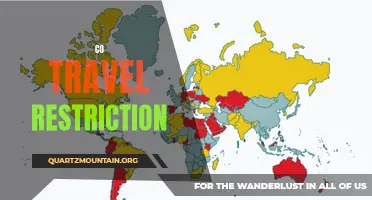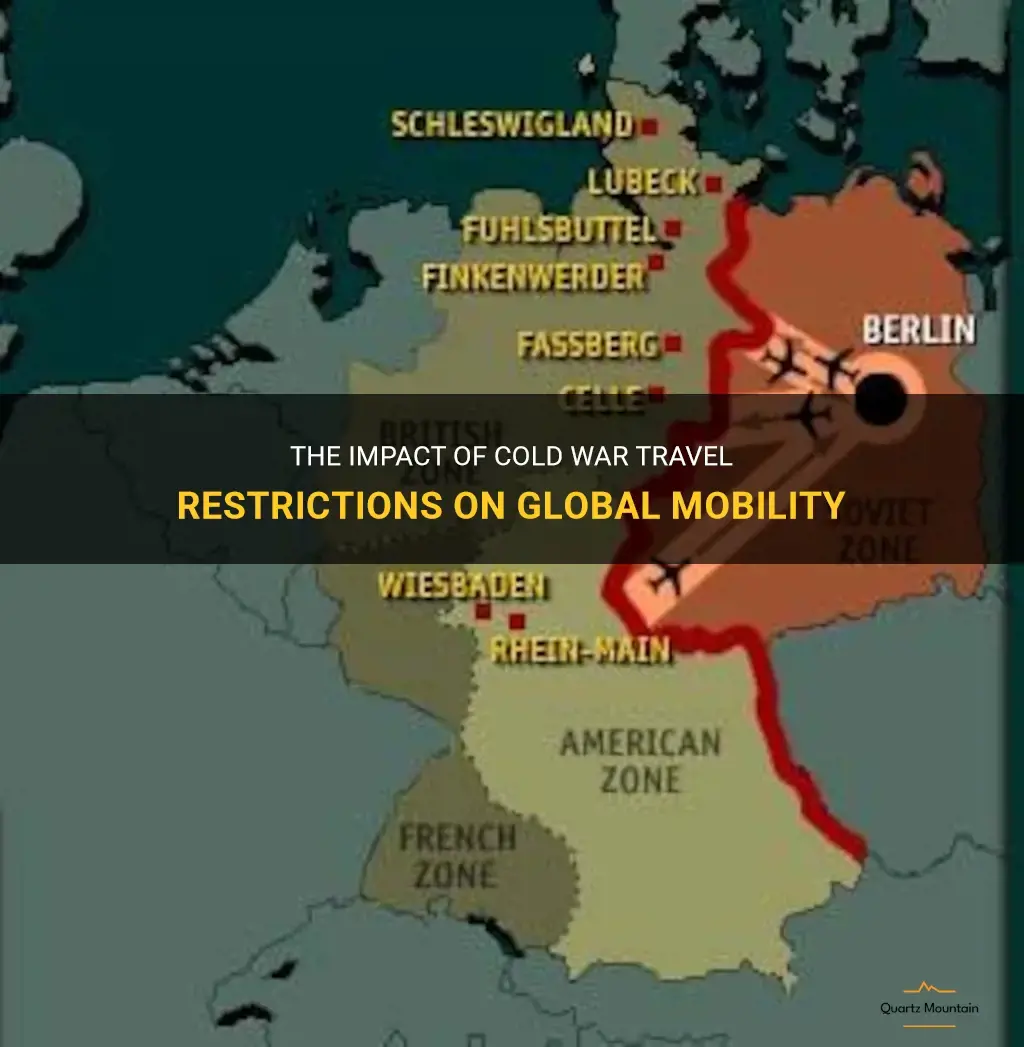
The Cold War was a time of intense political tension between the United States and the Soviet Union, and it had far-reaching effects on every aspect of life. One area that was particularly affected by the Cold War was international travel. Both the United States and the Soviet Union imposed strict travel restrictions on their citizens, creating a climate of fear and suspicion that made traveling between the two superpowers extremely difficult. These travel restrictions not only limited personal freedoms but also had a profound impact on cultural exchange and global understanding. In this article, we will explore the impact of Cold War travel restrictions and the ways in which they shaped the world as we know it today.
| Characteristics | Values |
|---|---|
| Period | 1947-1991 |
| Travel restrictions for citizens of communist countries | Severely restricted and highly regulated |
| Travel restrictions for citizens of non-communist countries | Relatively less restricted, but still regulated |
| Visa requirements | Stringent visa requirements for travel to communist countries |
| Restricted areas | Communist countries |
| Passport control | Strict passport control at borders and airports |
| Travel permissions | Required for travel to and from communist countries |
| Travel bans | Imposed on individuals considered a threat to national security |
| Exit visas | Required for citizens of communist countries to travel abroad |
| Diplomatic negotiations | Often required to facilitate travel to communist countries |
| Limited travel privileges | Allowed only for certain professions or government officials |
| Surveillance | Travelers from non-communist countries were closely monitored |
| Propaganda | Used to discourage travel to communist countries |
| Immigration policies | Often used to block emigration from communist countries |
What You'll Learn
- What were some of the major travel restrictions imposed during the Cold War era?
- How did the travel restrictions imposed by the Soviet Union differ from those imposed by the United States?
- Were there any countries that served as neutral zones during the Cold War, allowing limited travel between the East and the West?
- How did the travel restrictions affect individuals living in countries that were aligned with one of the superpowers?
- Did the travel restrictions have any long-term impacts on the relationship between countries and their citizens during the Cold War?

What were some of the major travel restrictions imposed during the Cold War era?
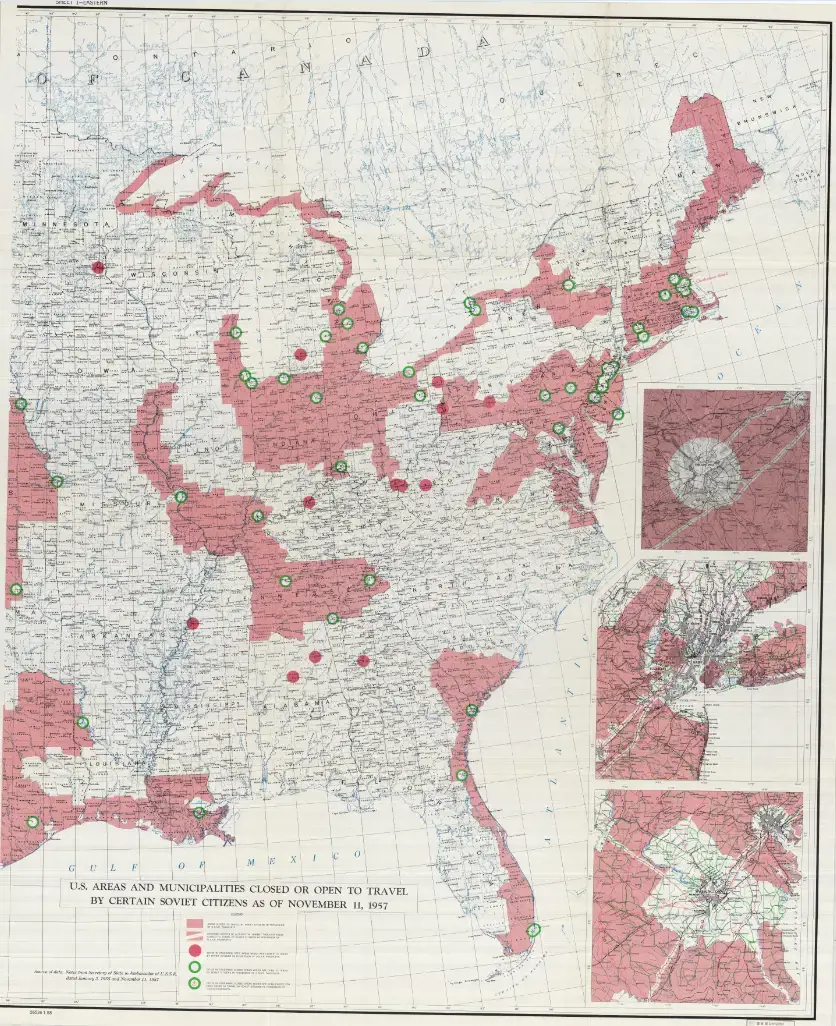
During the Cold War era, travel restrictions were a common feature as countries sought to control the movement of their citizens and prevent the spread of ideologies contrary to their own. The major travel restrictions imposed during this time varied across different regions and countries, but some common themes emerged.
One of the most well-known examples of travel restrictions during the Cold War was the Berlin Wall, which divided the city of Berlin into East and West. Erected in 1961 by the German Democratic Republic (GDR), the wall physically separated East Germany from West Germany and prevented its citizens from freely traveling to the West. This restriction was enforced through a system of guards, anti-vehicle trenches, and barbed wire, creating a heavily fortified barrier that remained in place until its fall in 1989.
In addition to the Berlin Wall, the Iron Curtain, a term coined by British Prime Minister Winston Churchill, was used to describe the extensive network of border controls and barriers that separated Western Europe from the Eastern Bloc. This included the construction of fences, minefields, and checkpoints along the borders of countries such as Poland, Hungary, Czechoslovakia, and Bulgaria. These restrictions limited the movement of individuals and reinforced the division between Western and Eastern Europe.
Furthermore, the Cuban Missile Crisis of 1962 highlighted the travel restrictions imposed by the United States in response to perceived threats from Soviet-aligned countries in the Americas. The U.S. implemented a travel ban on its citizens to Cuba, preventing them from visiting the communist nation. This restriction was put in place to isolate Cuba and limit Soviet influence in the Western Hemisphere.
The travel restrictions imposed during the Cold War were not limited to physical barriers and bans but also extended to visa requirements and restricted areas within countries. For example, the Soviet Union required foreigners to obtain a visa to enter the country, and certain areas, such as military installations and research facilities, were off-limits to foreigners. Similarly, the United States restricted travel to certain countries considered to be communist or under communist influence, such as North Korea and Vietnam.
Travel restrictions during the Cold War were a reflection of the geopolitical tensions and ideological conflict between the United States and its allies and the Soviet Union and its allies. These measures were intended to maintain control and prevent the spread of opposing ideologies, as well as to protect national security interests. However, they also created a sense of division and isolation, limiting the freedom of movement for individuals on both sides of the Iron Curtain.
Exploring Cameroon: Understanding the Current Travel Restrictions and Requirements
You may want to see also

How did the travel restrictions imposed by the Soviet Union differ from those imposed by the United States?
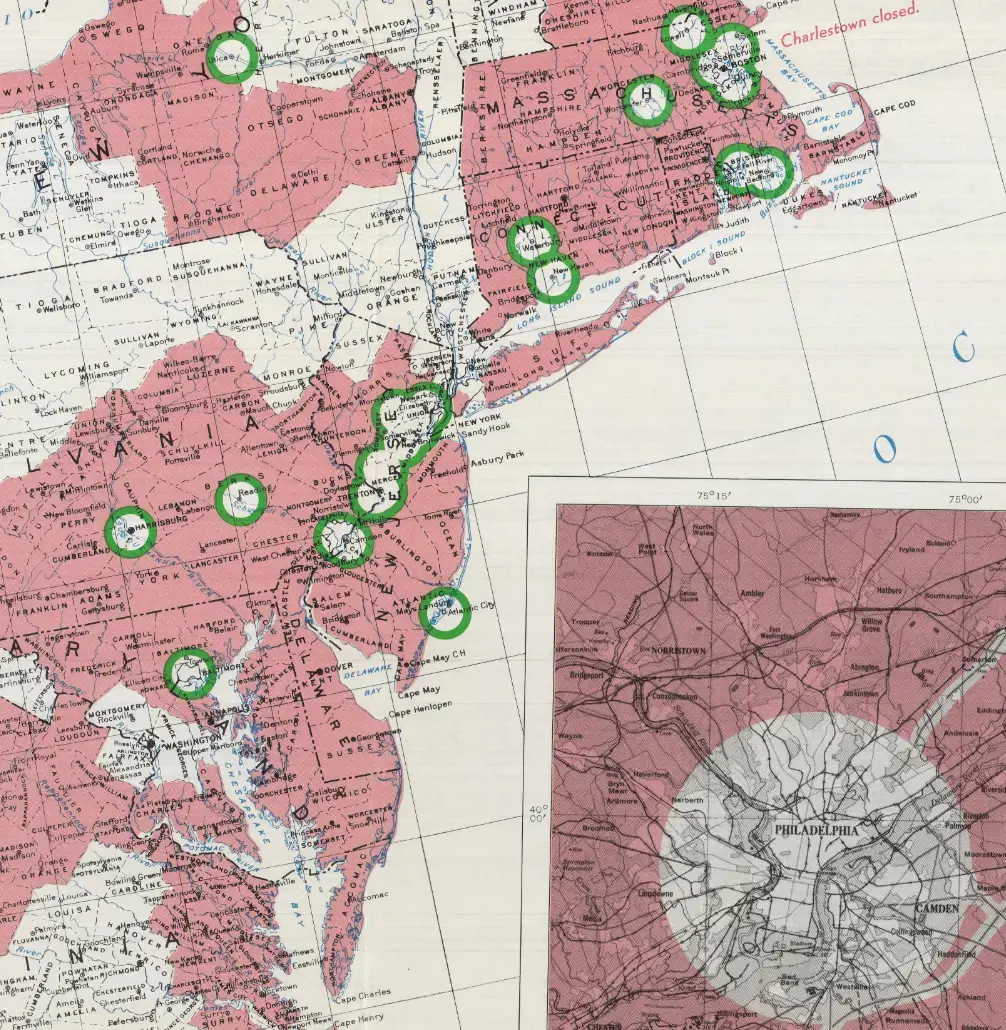
During the Cold War era, both the Soviet Union and the United States imposed travel restrictions on their citizens. However, these restrictions differed significantly in terms of purpose, scope, and severity.
The Soviet Union, under communist rule, implemented strict travel regulations as a means to control and limit contact with the outside world. The government closely monitored its citizens' movements in an effort to prevent the spread of dissenting ideas and ideologies. Travel within the Soviet Union was heavily regulated and required permits from authorities. In some cases, citizens were prohibited from leaving their hometowns or regions without a valid reason. International travel was even more restricted, with citizens needing special permission from the government to go abroad. The Soviet government actively discouraged its citizens from traveling to or engaging with capitalist countries, particularly the United States and its allies.
In contrast, the travel restrictions imposed by the United States were focused primarily on national security concerns, particularly during times of heightened tension. The U.S. government implemented various measures to protect its borders and prevent unauthorized individuals from entering the country. These restrictions were primarily aimed at immigrants and visitors from countries deemed as potential threats, such as communist nations or those with a history of terrorism. The United States also implemented travel restrictions during times of war or heightened security threats, often in the form of visa requirements or additional screening procedures.
While both the Soviet Union and the United States imposed travel restrictions, the severity and scope of these measures were significantly different. The Soviet Union's restrictions were deeply rooted in its communist ideology, aiming to isolate its citizens from the influence of capitalist societies and prevent the spread of dissent. The United States, on the other hand, focused on national security concerns and controlling the influx of individuals from specific countries or groups deemed as potential threats.
Furthermore, the consequences for violating travel restrictions were also different in each country. In the Soviet Union, unauthorized travel or attempting to leave the country without permission could result in severe punishments, including imprisonment or loss of employment opportunities. In the United States, violations of travel restrictions were typically treated as immigration offenses and the consequences varied depending on the specific circumstances.
In conclusion, the travel restrictions imposed by the Soviet Union and the United States during the Cold War era differed in purpose, scope, and severity. While the Soviet Union sought to control and limit contact with the outside world to prevent the spread of dissent, the United States focused on national security concerns and controlling the influx of individuals from potentially threatening countries. These differences highlight the contrasting ideologies and priorities of the two nations during this period of intense geopolitical rivalry.
Navigating the Big Island: Understanding Travel Restrictions in Hawaii
You may want to see also

Were there any countries that served as neutral zones during the Cold War, allowing limited travel between the East and the West?
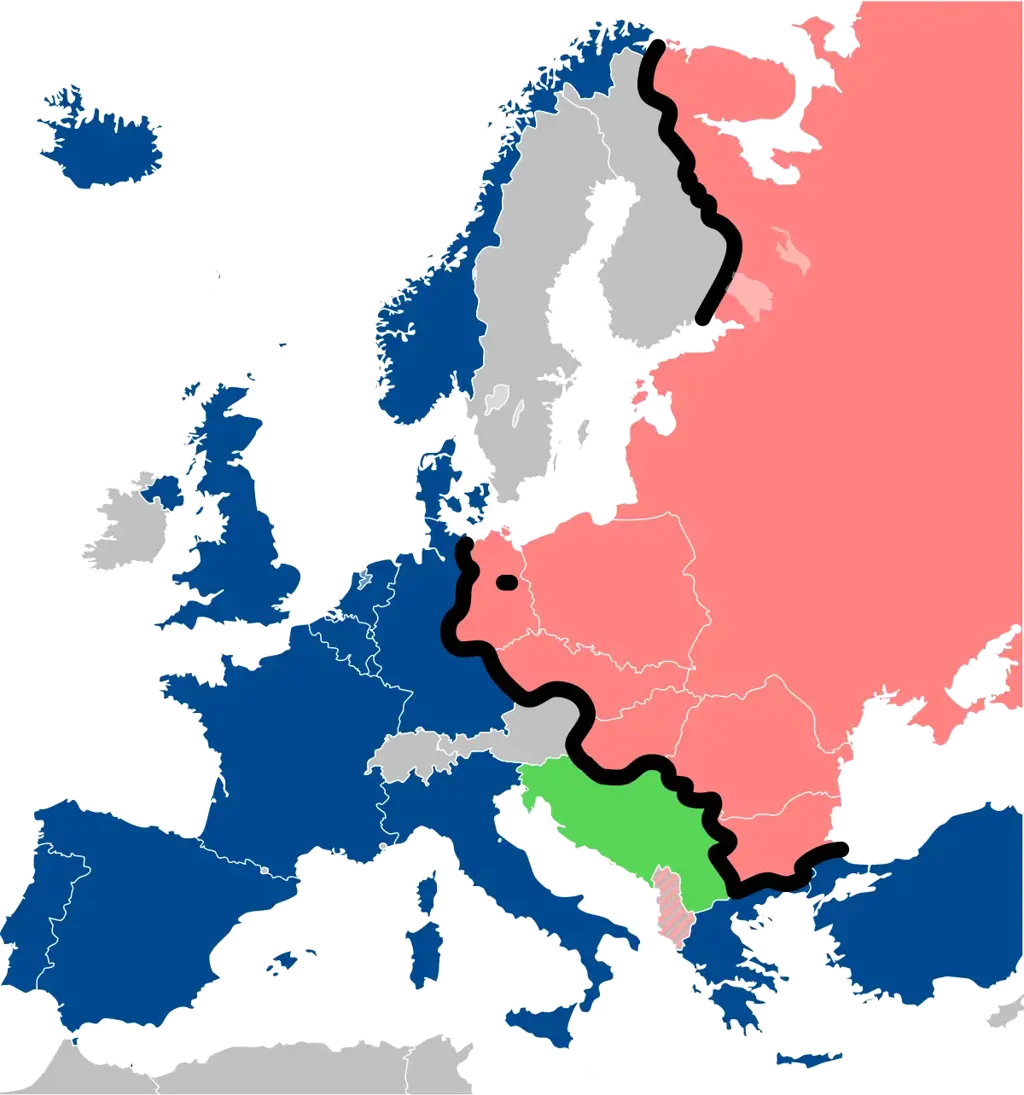
During the Cold War, the world was divided into two ideological camps - the East, led by the Soviet Union, and the West, led by the United States. This ideological divide and tension often made travel between these two sides difficult and restricted. However, there were a few countries that served as neutral zones, allowing limited travel and communication between the East and the West.
One such country was Finland. Throughout the Cold War, Finland pursued a policy of neutrality, positioning itself as a bridge between East and West. This allowed the country to maintain diplomatic relations and trade with both sides, while also providing a safe haven for individuals seeking to escape from the other side. Finland's capital, Helsinki, became a hub for international diplomacy and a meeting place for officials from both sides of the Cold War divide.
Another neutral country during the Cold War was Austria. Situated in the heart of Europe, Austria had a long history of neutrality and served as a meeting ground for East and West. Vienna, the capital of Austria, was home to various international organizations such as the United Nations Office in Vienna and the Organization for Security and Cooperation in Europe. These institutions provided platforms for dialogue between the two sides, facilitating limited travel and communication.
Switzerland is another notable example of a neutral country during the Cold War. Renowned for its long-standing neutrality and financial stability, Switzerland became a center for diplomacy and international negotiations. The city of Geneva, in particular, was host to many conferences and negotiations between the East and the West, including the historic Summit Conference between U.S. President Ronald Reagan and Soviet General Secretary Mikhail Gorbachev in 1985.
Additionally, Sweden and Yugoslavia also held neutral positions during the Cold War. Sweden, though not part of any formal alliances, maintained a policy of non-alignment and played a significant role in international diplomacy. Yugoslavia, on the other hand, pursued a policy of non-alignment during the Cold War, positioning itself outside both the Eastern and Western camps.
These neutral countries served as crucial meeting places and facilitators of limited travel and communication between the East and the West. Although travel and communication were restricted during the Cold War, individuals, organizations, and diplomats could make use of these neutral zones to exchange information and engage in negotiations. The existence of these neutral countries played a significant role in maintaining some level of contact and dialogue between the two sides during this tense period in world history.
Understanding Broward County Travel Restrictions: What You Need to Know
You may want to see also

How did the travel restrictions affect individuals living in countries that were aligned with one of the superpowers?
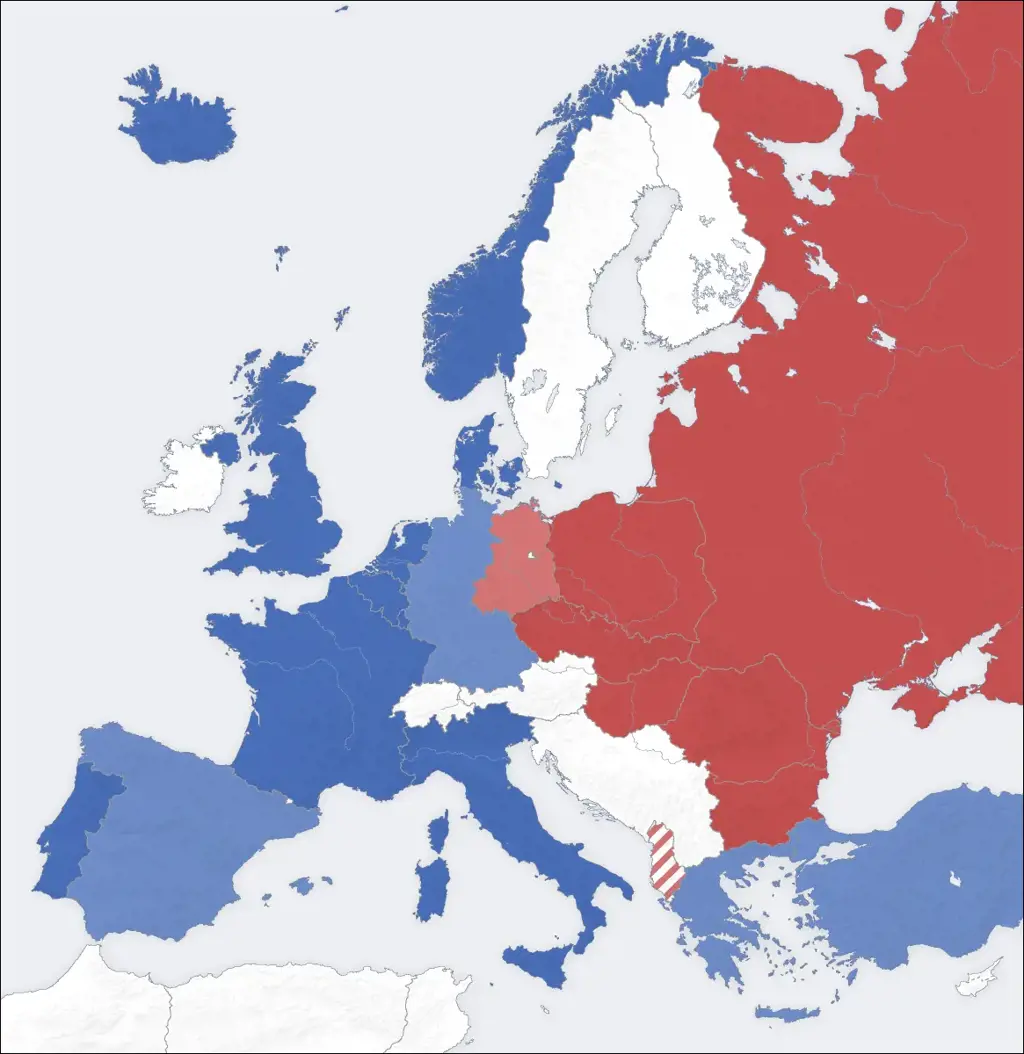
The travel restrictions imposed during the Cold War had a profound impact on individuals living in countries that were aligned with one of the superpowers. These restrictions significantly limited the freedom of movement for citizens, leading to a number of consequences for individuals and their respective countries.
One of the primary effects of travel restrictions was the isolation of individuals and the hindrance of cultural exchange. People living in countries aligned with either the United States or the Soviet Union found it incredibly difficult to travel to the other side. This prevented individuals from experiencing different cultures, traditions, and ways of life. The lack of cultural exchange limited the understanding and empathy between citizens of different nations, perpetuating stereotypes and misunderstandings.
The travel restrictions also had economic implications for countries aligned with a superpower. The inability to freely travel for business purposes hindered trade relationships and limited economic growth. Without access to global markets, countries aligned with a superpower were at a disadvantage in terms of international business opportunities. This furthered the economic divide between nations and prevented individuals from taking advantage of potential job opportunities abroad.
Moreover, these restrictions impacted personal relationships and family connections. People living in countries aligned with a superpower often found themselves separated from their loved ones who lived in different countries. Families were torn apart, and individuals were unable to visit or reunite with their relatives. This had a profound emotional toll on individuals and led to a sense of longing and instability in their personal lives.
Additionally, the travel restrictions acted as a form of political control. Governments aligned with a superpower used these restrictions to maintain a tight grip on their population and prevent the spread of dissenting ideas. By limiting travel, these governments restricted access to different political ideologies and prevented their citizens from gaining alternative perspectives on global affairs. This furthered the divide between the aligned nations and hindered the development of independent thought and critical thinking among the population.
In conclusion, the travel restrictions imposed during the Cold War had far-reaching effects on individuals living in countries aligned with either the United States or the Soviet Union. These restrictions limited cultural exchange, hindered economic growth, separated families, and acted as a tool for political control. The consequences of these restrictions were felt on both personal and national levels and continue to shape the legacy of the Cold War today.
Brighter Days Ahead: Navigating Baleares Travel Restrictions for a Memorable Vacation
You may want to see also

Did the travel restrictions have any long-term impacts on the relationship between countries and their citizens during the Cold War?

During the Cold War, travel restrictions were a common feature in many countries. These restrictions were imposed by both the Western Bloc and the Eastern Bloc as a means to control the movement of their citizens and prevent the spread of what they considered to be dangerous ideas and influences. As a result, the relationship between countries and their citizens was significantly impacted.
One of the most significant long-term impacts of these travel restrictions was the erosion of trust and understanding between countries and their citizens. When individuals were prohibited from traveling to other countries, they were effectively cut off from experiencing different cultures and perspectives. This lack of exposure to different ideas and ways of life led to a sense of isolation and distrust among citizens, who saw the restrictions as a way for their governments to control and manipulate them.
Furthermore, travel restrictions also created a sense of fear and paranoia among citizens. With limited access to information and a lack of personal experiences with people from other countries, citizens were left to rely on government propaganda and stereotypes, which often portrayed foreigners as dangerous and hostile. This fear further deepened the divide between countries and their citizens, as it made it difficult for individuals to develop a nuanced understanding of other cultures and societies.
In addition, the travel restrictions also had economic implications. With limited access to foreign markets and limited opportunities to engage in international trade and tourism, countries and their citizens missed out on potential economic benefits. This restricted economic growth and stifled innovation, as individuals and businesses were unable to collaborate and share ideas with their counterparts in other countries.
However, despite the negative impacts, the travel restrictions also had some unintended positive consequences. For example, the restrictions forced countries to invest in their domestic industries and develop self-sufficiency. As a result, some countries were able to develop thriving industries and become more resilient in the face of global economic changes. Additionally, the restrictions also led to a focus on domestic tourism, which fostered a sense of national pride and identity among citizens.
In conclusion, the travel restrictions during the Cold War had long-term impacts on the relationship between countries and their citizens. These restrictions eroded trust and understanding, created fear and paranoia, and restricted economic growth. However, they also led to some unintended positive consequences, such as increased self-sufficiency and a focus on domestic tourism. Overall, the travel restrictions during the Cold War had a profound impact on the relationship between countries and their citizens, shaping their perceptions and attitudes towards each other for decades to come.
Understanding Canada's DUI Travel Restrictions: What You Need to Know
You may want to see also
Frequently asked questions
During the Cold War, travel restrictions were put in place by both the United States and the Soviet Union. Many countries, especially those in Eastern Europe under Soviet control, had severe travel restrictions that limited their citizens' ability to travel outside the country. Similarly, the United States restricted travel to Soviet Bloc countries, making it difficult for Americans to visit these areas.
No, the travel restrictions during the Cold War were not limited to just citizens of the United States and the Soviet Union. These restrictions applied to citizens of all countries, as many nations aligned themselves with either the United States or the Soviet Union during this time. As a result, citizens of these countries also faced travel restrictions and limitations to certain areas.
Travel restrictions during the Cold War had a significant impact on families and individuals. Many families were separated and unable to reunite due to the restrictions on travel. Individuals were often unable to visit relatives or friends living in different countries, leading to a sense of isolation and disconnect. Additionally, the restrictions hindered cultural exchange and limited opportunities for people to experience different cultures and perspectives.
Yes, there were some exceptions to the travel restrictions during the Cold War. Certain professionals, such as diplomats and journalists, were often granted special travel permits to facilitate their work. Additionally, there were some limited instances of cultural exchange programs that allowed select individuals to travel between countries for educational or artistic purposes. However, these exceptions were rare and heavily regulated.




